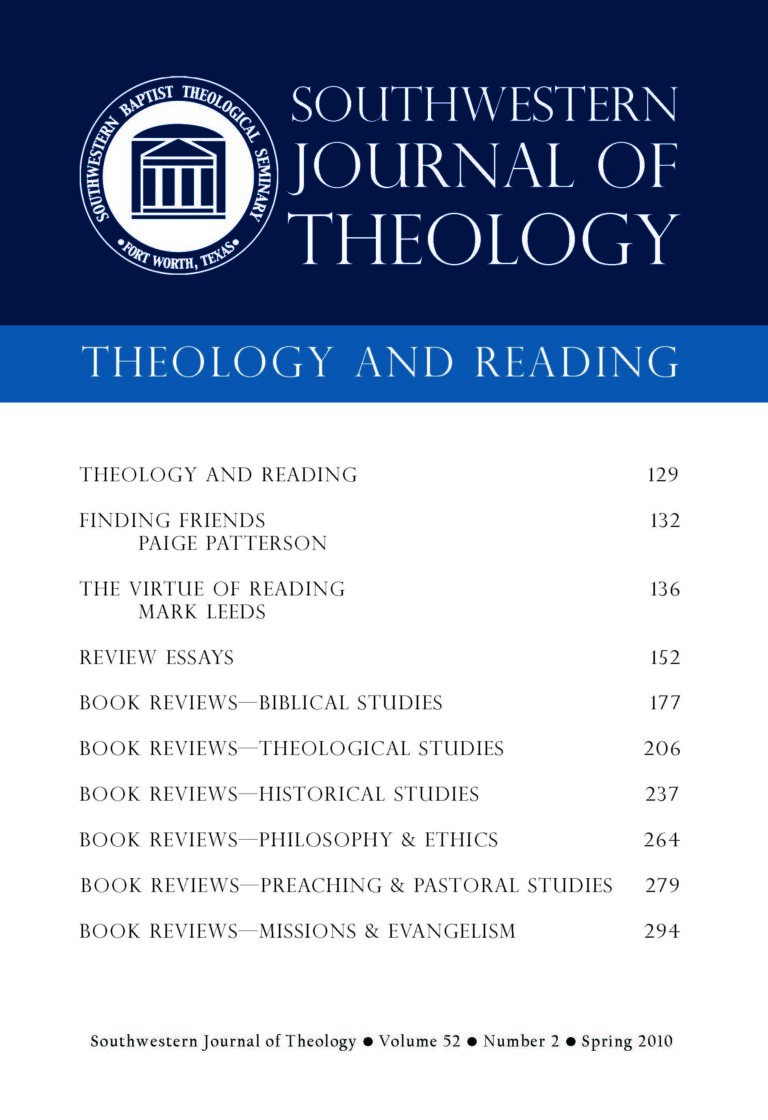
Theology and Reading
Southwestern Journal of Theology
Volume 52, No. 2 – Spring 2010
Managing Editor: Malcolm B. Yarnell III
The Two Horizons New Testament Commentary. By Ruth Anne Reese. Grand Rapids: Eerdmans, 2007. 220 + x pages. Paperback, $20.00.
Ruth Anne Reese, associate professor of New Testament at Asbury Seminary, provides a unique commentary on 2 Peter and Jude that aims to bring together exegesis and theology in a partnership in order to illuminate the text (1). The Two Horizons New Testament Commentary series is written for students, pastors, and Christian leaders who want to interpret Scripture theologically and not only exegetically or historically. Building on the metaphor of an interpretive dance, Reese describes the goal of the commentary “to build a dance pavilion . . . where exegesis, theology, and the community of believers can gather and join the dance” (2).
Reese treats both Jude and 2 Peter with three chapters: an introductory chapter, an exegetical chapter (working paragraph-by-paragraph instead of verseby-verse), and a chapter exploring theological horizons. The theological horizons chapter is further divided into three sections: theological themes, theology within the context of the canon, and theology in contemporary contexts (the chapter on 2 Peter combines the latter two sections).
While acknowledging the value of historical research (9), Reese notes that most of the introductory historical questions (authorship, date, provenance, destination) address “very little in terms of the issues that the epistle at hand is concerned with” (8). Because of this conviction, little space is devoted to introductory questions (18; the six page defense of Petrine authorship of 2 Peter is a notable exception; 115–121). Reese implies that Jude preceded 2 Peter (118), but devotes little space to their relationship because “a close reading of the contexts into which the material is set reveals two distinct purposes and situations” (14). Reese also discusses the language of Jude and 1 Peter (11–13; particularly allusion and metaphor), cultural values and relationships in the first century (20–23; honor/ shame, purity/impurity, individual/community, patrons/clients), and the role that narrative theology plays in helping interpret these books within the context of the canon (25–26).
Reese addresses the following theological themes in Jude: denying God and the bid for false freedom, judgment, keeping and being kept (with discussion of the broader Arminian/Calvinist debate), us and them, remembering, and the call to faithful living. The canonical section primarily explores the Old Testament background for Jude’s examples, and the discussion of Jude’s theology within our contemporary contexts focuses on the relationship between “the Beloved” and “the Others.” The following are theological themes addressed in 2 Peter: God and Jesus Christ, ethics, and eschatology.
Reese ably accomplishes the goals for the commentary. The theological and canonical focus surpasses that which is provided by other commentaries in the field. The scarcity and unobtrusiveness of technical footnotes will make the volume accessible to its target audience. Reese does discuss the Greek throughout, but in a manner accessible to the non-specialist. The discussion of contemporary theological contexts is particularly insightful. Reese’s particular synthesis of the relationship between Jesus, ethics, and eschatology (201–220) deserves careful attention, especially in light of the question, “What sort of people ought we to be” (2 Pet 3:11). Jesus provides believers with all that is needed for life and godliness while they wait for and hasten the final eschatological day of salvation and judgment.
Two particular theological issues, however, are not adequately addressed. First, Reese does not discuss the theological difficulties involved with Jude’s use of extra-biblical sources as authoritative, seemingly on the same level as the Old Testament. How does this usage impact theological discussions of canon, inspiration, and inerrancy (especially Jude’s attribution of the quotation from 1 Enoch to Enoch, the seventh from Adam)? Second, Reese writes “The ethical life is the way of securing the gift of entry into the eternal kingdom (1:11)” (191). Although Reese rightly points out that “[r]ighteous living is the response of believers to the redemptive work that God performs” (191), there is no extended discussion of the soteriological relationship between faith and works. Reese rightly emphasizes the necessity of ethical living in the lives of believers, as Jude and 2 Peter make clear, but this is not sufficiently discussed in relationship to the canon. In what way does one’s ethical life secure the gift? These are theological questions crying out to be addressed.
Despite these concerns, Reese has provided a unique contribution to the study of 2 Peter and Jude. Because of this commentary’s emphasis on theology and relative lack of interest in traditional historical concerns it will not function as a replacement for standard technical commentaries (i.e. Richard Bauckham, Jerome Neyrey), but within its particular focus (theological and canonical interpretation) it surpasses that which is offered by others and will function well as a supplemental commentary, possibly even the primary commentary of busy pastors and lay teachers.





